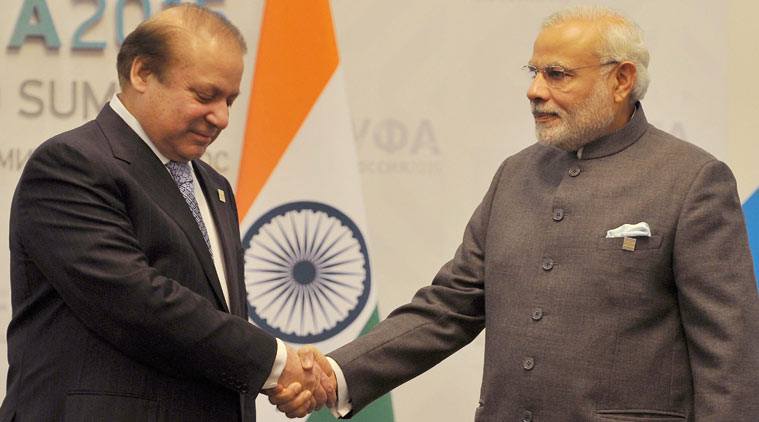
 File photo of Pakistan PM Nawaz Sharif and PM Narendra Modi. (Source: PTI)
File photo of Pakistan PM Nawaz Sharif and PM Narendra Modi. (Source: PTI)
Pakistan is there. It is on India’s western border (and until 1971 was also on the eastern border). It cannot be wished away; nor can India pretend it will go away.
On the very day the two countries became independent, they inherited a clutch of problems that was the inevitable result of Partition. I know of no example in history where two countries born out of a division of land lived in peace ever after.
Learn and forget
History also teaches us that such countries must learn to live with each other, and the only way to peaceful co-existence is to talk to each other. If that means talking to each other every day or every week or every month, so be it.
That lesson was learnt and forgotten and relearnt many times since 1947. Every government in India — and needless to say every government in Pakistan — was guilty on that count.
The period after the Mumbai terror attacks in 2008 was a particularly difficult period. It was akin to the post-war situation in 1965, 1971 and 1999. In a sense it was worse because it brought the conflict from the borders to the heart of India. The mood in India was bitter and implacably opposed to Pakistan: no to talks, no to exchanges, no to cricket, no to everything. The Government could not ignore the anger among the people; yet there was no way forward but to negotiate the hurdles and find a way to engage with Pakistan.
The UPA governments (first and second) tried to do that, and got mixed results.
Fast forward to 2013. Enter Mr Narendra Modi. He had adroitly positioned himself as the alternative to Mr L K Advani, who was increasingly seen as not a winner. He had also successfully positioned himself as the alternative to the Congress party. Within the BJP, it was Mr Modi versus Mr Advani. In the country as a whole, it was Mr Modi versus Congress.
Such positioning required a new rhetoric, laced with hyperbole, that presumably reflected the mood of the people. It is here that Mr Modi scored over every other political leader in the country.
Modi on talks with Pakistan
In the context of Pakistan, let me recall some of the statements that he made in 2012 and in the run-up to the elections in May 2014.
On December 12, 2012, Mr Modi said, “Delhi is working behind the scenes, keeping people in the dark and making a deal with Pakistan.”
At Tiruchirappalli, Tamil Nadu, on September 26, 2013, Mr Modi said, “Pakistan army can behead Indian soldiers. Still, the Delhi government eats chicken biryani with the Pakistan Prime Minister in the name of protocol.”
When the election results were a few days away, on May 8, 2014, a supremely confident Mr Modi, answering a specific question on the Composite Dialogue process, said, “Is it possible to have a discussion amidst bomb blasts and gun shots? So, to have a reasonable discussion, first the blasts and the gun shots have to stop.”
The statements evoked both praise and concern. They appealed to certain sections that the BJP was trying hard to woo. They also raised serious concerns among diplomats and security experts. Was Mr Modi setting the bar at an impossibly high level that no talks with Pakistan would be possible during his entire term?
However, Mr Modi surprised everyone by inviting all SAARC leaders, including the Prime Minister of Pakistan, to his swearing-in. It was a political masterstroke and led the world to believe that the rhetoric of the elections would be left behind.
Is there a strategy?
In retrospect, every assessment was wrong. Neither the rhetoric nor the masterstroke was the result of a carefully thought out strategy. Much of it was impulsive. The months that followed proved that the new government simply lacked a strategy to deal with Pakistan. Recall the starts and stops and the twists and turns of the last 18 months. Invitations and cancellations and handshakes and cold stares left the world bewildered, as they did most discerning observers in India. The sum and substance of the last 18 months was that the Government of India had no policy on Pakistan.
It was also clear that policy-making had been taken away from the Ministry of External Affairs and vested completely in the Prime Minister’s office. The Minister had been reduced to Minister for rescuing stranded people. Seasoned diplomats had been assigned crucial jobs in Event Management.
In the last few days, the Government has sprung another surprise. Despite a 25 per cent increase in infiltrations this year over last year, reported by the BSF, India and Pakistan have decided to talk to each other. Secret talks are no longer taboo. Back channels are no longer suspect.
Ms Sushma Swaraj has taken the position of centre-forward. Almost miraculously, the once-shunned Composite Dialogue has metamorphosed into Comprehensive Bilateral Dialogue. Everything is on the table — from Jammu & Kashmir to counter-terrorism, from Siachen to Sir Creek, from economic cooperation to people-to-people exchanges.
If all these are part of a serious strategy, we must welcome the change. There will be challenges and the ride will be bumpy but there is no substitute to staying the course. No one expects miraculous solutions to all the issues, but no one wants conflict or war.
![]()
Source: New feed






